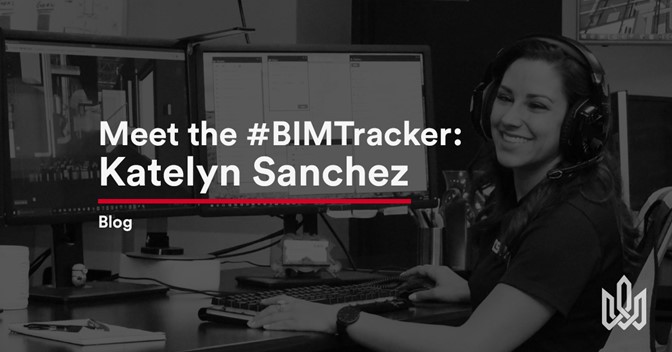We’re proud to introduce the latest member of our Meet the #BIMTracker series: the indomitable Katelyn Sanchez, VDC/BIM Coordinator Cache Valley Electric, one of the nation’s premier electrical contractors.
What first got you into BIM?
So the first major building block of my career was actually woodworking in high school. That’s how I got started in all this [world of construction]. I’m a 2-time State Champion cabinet maker with an organization called Skills USA. I got to compete in my junior and senior years; I won State in my senior year and got to compete at National level. In the end, as I was trying to decide what to do as a career, I realized I didn’t want to be the one who built it: I wanted to design.
I pursued an Associates Degree in Architectural / Engineering Drafting Technology. As I was participating at college level, I was also taking furniture making and building classes and competing at a National level. To this day, it’s still a big hobby of mine.
The lightbulb moment of BIM for me was that connection of seeing something built virtually before it was built on-site. [On the design side], we get to be that bridge between design to construction. It’s awesome to be able to see both sides. And solving problems before you see them on-site; that fascinates me.
So my college education snowballed into that being my foundation and building block to my career today. I’m proud I worked 3 jobs in college too. When I graduated, I was brought into an engineering firm, Bridgers and Paxton. I was there almost 8 years and was a BIM coordinator as well as a mechanical designer. Being a BIM coordinator for the design side is totally different than construction. After that was recruited with a GC firm, and spent 2 years as a BIM coordinator, and about a year ago, was recruited again for Cache Valley Electric as VDC / BIM Coordinator where I’m happily working now!
What’s your favorite part about your role as BIM/VDC Coordinator at Cache Valley Electric?
I like to be at the forefront of a project. Like to be in the preconstruction, the communication, building those relationships with our GCs and in-house field crews. At Cache Valley, I love that I’m able to get in into this process early.
It’s also awesome being part of a company that’s over 104 years old. That really says a lot to me, when you can say you’re part of a company that’s over 100 years old. Not only that, the company has been family-owned for the entire duration.
What has been your most memorable project to date?
My most memorable project to date would have to be the first project I had working as a BIM coordinator, working for HB Construction in New Mexico. It was a courthouse in a little town called Lovington in New Mexico. That particular courthouse was 6 levels that included a penthouse and a basement.
It was my first project coordinating directly with subcontractors, superintendents, design, and engineering. It was hard at times especially with that old school feeling of “We don’t need digital coordination, we can do it on-site” vs the known advantaged of finding the issues before they happen.
When the project was all said and done we discovered that the issues we had found in advance would have run into thousands and thousands of dollars. I like to think we won some hearts and minds on that project. It can sometimes feel like a never-ending task!
I find this particularly true when coming into a role where we are dealing with teams outside of New Mexico, and especially as a young woman. “Who is this bubbly girl coming in and trying to make me communicate?”.
On a daily basis, being a woman in the industry, I’m seen by those who don’t know me as someone who doesn’t necessarily know what she’s doing, until you present the facts. Being on the design / construction side for local firms in New Mexico, you’re known. But now, working on projects further afield, I need to rebuild those relationships and overcome that barrier a little bit.
What was your first impression of BIM Track?
My first time hearing about BIM Track was from a colleague at HB Construction. We did some investigative work of tools that could help us ease that communication pain.
We played with it a little bit, but the real gamechanger was when one of the team presented BIM Track to us. We also finally understood setting up shared coordinates properly was a must-have! We started out using it for internal coordination, and quickly realized the value of bringing our GCs into BIM Track; especially when it comes to hub settings and validating resolved issues.
How do you explain BIM Track to those who have never heard of it before?
A platform that connects all teams together for better coordination workflows. BIM Track to me is an option to interconnect all software to coordinate together, so you’re not jumping from one to the next. That’s amazing to me. Autodesk tries to do that with C4R, different platforms they present. BIM Track is that software we can utilize on everything. But make sure you sort out your coordinates 😉
What gets you excited about the future of this industry?
That it’s ever-changing with the technology, and my role has changed with that too. Keeping up with the technology and being willing to learn about new processes and workflows to support that is really the name of the game.
If BIM Track was a drink, what would it be and why?
A Moscow mule, cause it’s smooth and refreshing.
- Alexine Gordon-Stewart






 Katelyn Sanchez
Katelyn Sanchez